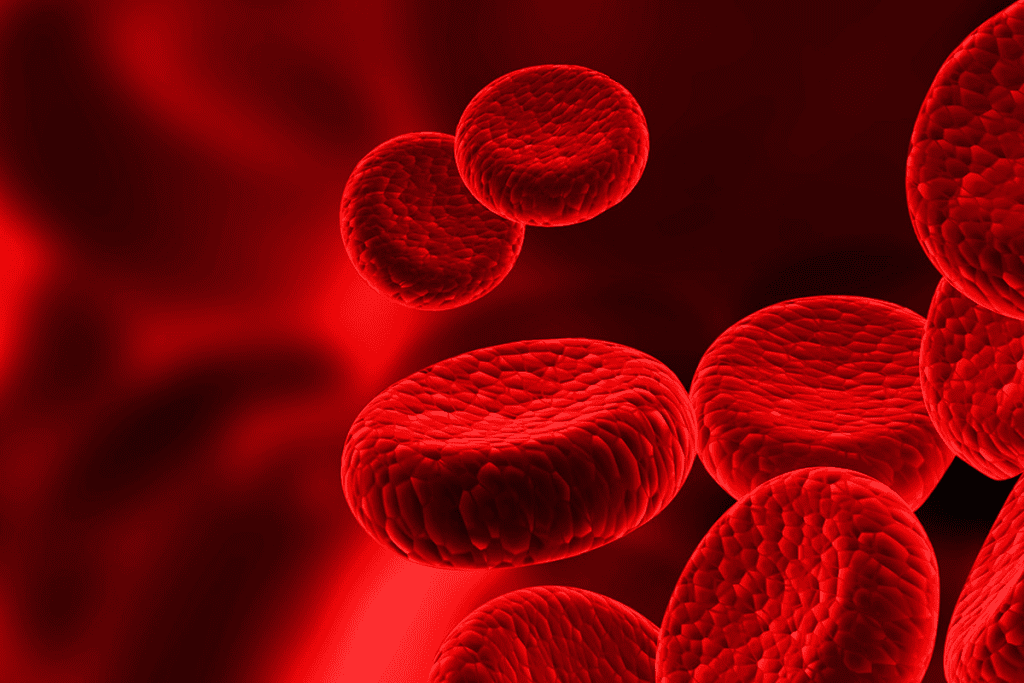Last Updated on November 13, 2025 by
Does prednisone make you sweat? Uncover this terrible side effect of the drug. Crucial information for patients managing the powerful steroid’s effects.
Prednisone, a common corticosteroid, can change hemoglobin levels in some patients.
Studies show that prednisone therapy can raise hemoglobin in those with anemia and cytopenia. For example, a Yale University study found a big jump in hematocrit and hemoglobin levels during prednisone treatment.

We will look into how prednisone affects hemoglobin levels. This will help us understand its impact on blood counts in patients with certain blood disorders.
Prednisone is a corticosteroid medication used to manage many health issues. It affects the body’s systems like the heart, muscles, nerves, and immune system. This helps keep the body in balance.
Prednisone is a man-made corticosteroid that acts like cortisol, a hormone from the adrenal glands. It’s used for its strong anti-inflammatory and immune-suppressing effects.
Prednisone works by binding to glucocorticoid receptors in cells. This changes how genes work, leading to less inflammation and immune activity. It does this by:
Prednisone is used for many health issues, like inflammatory diseases and autoimmune disorders. It’s also used for asthma, rheumatoid arthritis, lupus, and severe allergies.

Knowing how prednisone works helps us see its importance in healthcare. It plays a key role in managing complex health problems.
Corticosteroids like prednisone are key in making blood cells. We’ll look at how prednisone changes blood parameters. This includes its role in making blood cells, the difference between corticosteroids, and its effect on bone marrow.
Corticosteroids, like prednisone, affect how blood cells are made. Prednisone can increase hemoglobin and red cell content in the blood. It does this by slowing down the breakdown of red blood cells.

It’s important to know the difference between mineralocorticoids and glucocorticoids. Mineralocorticoids control electrolytes, while glucocorticoids, like prednisone, affect inflammation and metabolism. This helps us understand how prednisone changes blood parameters.
Prednisone also affects bone marrow, which is key for blood cells. Studies show corticosteroids can boost red blood cell production. This can raise hemoglobin levels and improve red blood cell counts.
In summary, prednisone’s effects on blood are complex. It involves its role in making blood cells, its type as a glucocorticoid, and its impact on bone marrow. Knowing these details helps us see how prednisone can help with blood-related issues.
Studies have shown how prednisone affects hemoglobin levels. We’ll look at the evidence that supports its use in raising hemoglobin. This includes case studies and research findings.
A case series found a big jump in hemoglobin levels. It went from 7.5 g/dL to 17.5 g/dL in just one month. This shows prednisone’s power in treating low hemoglobin conditions.
High-dose glucocorticoids, like prednisone, quickly boost hemoglobin. This is key for those with severe anemia or similar issues.
Yale University’s research on prednisone’s impact on blood is enlightening. It shows prednisone can significantly raise both hematocrit and hemoglobin. This highlights its therapeutic benefits.
This research helps us understand how prednisone affects blood. It supports its use in treating low hemoglobin or hematocrit conditions.
Studies have compared different steroids, like dexamethasone and prednisone, on hemoglobin. Both can raise hemoglobin, but their strength and how long they last differ.
Knowing these differences helps doctors choose the best steroid for patients needing higher hemoglobin levels.
In summary, the evidence backs up prednisone’s role in increasing hemoglobin. This has big implications for managing related conditions. More research could reveal more about prednisone and other steroids in treatment.
It’s important to know how prednisone affects red blood cell production. Prednisone, a common corticosteroid, can boost the creation of red blood cells. This is known as an erythropoietic effect.
Prednisone might work by speeding up red blood cell breakdown or by activating certain enzymes. The exact ways are complex and involve many pathways. A study found that prednisone could help make more red blood cells, similar to how corticosteroids do.
This process is vital for patients with anemia or other conditions affecting red blood cell count.
Erythropoietin is a hormone key to making red blood cells. Prednisone’s effect on erythropoietin pathways can make its red blood cell-making effects stronger. Research shows that corticosteroids can change how erythropoietin is made and used, affecting red blood cell production.
How people react to prednisone can differ a lot. Things like the condition being treated, the amount of prednisone taken, and the person’s health can all play a part. Knowing these factors is key to getting the best results from treatment.
In summary, prednisone’s effects on making red blood cells are complex and involve many steps. More research is needed to fully understand how prednisone can help with conditions related to red blood cell production.
Prednisone, a corticosteroid, is being studied as a treatment for anemia and cytopenia. We will look at recent research that shows its effectiveness in these conditions.
Research from 2023 found that low-dose prednisone works well for cytopenia that doesn’t respond to other treatments. This study shows prednisone could be a good option for those with few treatment choices.
A 2023 study showed that low-dose prednisone helped 100% of patients with treatment-resistant cytopenia. This finding highlights prednisone’s value in medical treatment.
The success rate of prednisone treatment is impressive. In studies, patients who didn’t respond to other treatments saw big improvements with prednisone.
Clinical studies show recovery rates of 60% to 66.7% in patients treated with prednisone for anemia and cytopenia. These numbers show a positive response to prednisone therapy.
Prednisone is a valuable treatment for managing anemia and cytopenia. As more research comes out, its role in medicine is expected to grow.
Many people ask, does Prednisone make you sweat? Prednisone can cause a lot of sweating, making many wonder why. We’ll look into why this happens and how to handle it.
Corticosteroids, like prednisone, affect the body in many ways. They can mess with the endocrine system, leading to more sweat. This is because they change the body’s hormonal balance, which can make you sweat more.
The mechanism involves the impact of corticosteroids on the hypothalamic-pituitary-adrenal axis. This axis is key in controlling body temperature and sweat. So, people on prednisone might sweat more.
Not all steroids make you sweat the same way. For example, dexamethasone might affect sweating differently than prednisone. Knowing these differences helps doctors choose the right steroid for you.
To deal with too much sweating from prednisone, try a few things. Wear clothes that breathe and keep cool. Also, practicing stress-reducing techniques like meditation can help. Stress makes sweating worse.
By using these tips, you can manage the sweating side effect of prednisone. This will make your treatment more comfortable.
Prednisone therapy can have many side effects that affect different parts of the body. It’s good for treating many health issues but comes with risks. It’s important to think about these risks carefully.
Prednisone can cause mood changes, increased hunger, and trouble sleeping in the short term. It can also make you retain fluid, causing swelling in your legs and feet. Plus, it can mess with how your body handles blood sugar, leading to high blood sugar.
Using prednisone for a long time can lead to serious side effects. One big risk is osteoporosis, because it messes with calcium in your body. Long-term use can also cause adrenal insufficiency, where your adrenal glands don’t make enough cortisol.
Some of the long-term risks include:
Regular checks with your healthcare provider are key to managing prednisone’s risks. These visits help track how you’re doing and watch for side effects. Your doctor might do blood tests, bone density scans, and eye exams to keep an eye on things.
Knowing about prednisone’s side effects and monitoring closely can help doctors reduce risks. This way, they can make sure patients get the best care possible.
Prednisone therapy needs careful thought. It’s important to weigh its benefits in raising hemoglobin against possible side effects. At Liv Hospital, we follow the latest research to give our patients the best care.
Doctors must think about both the good and bad of prednisone. It can help increase hemoglobin but might also cause too much sweating. We look at each patient’s health and past to lower risks.
For example, some patients might sweat more because of their health history. Knowing this helps us create a plan that works well for them.
Choosing the right patients for prednisone is key. We check their condition, medical history, and how they might react to the treatment.
Working together is vital for planning treatment with prednisone. Doctors from different fields team up for a complete care plan.
This teamwork helps us address the patient’s needs now and think about their future health. It helps manage side effects and make sure prednisone works well.
Prednisone helps increase hemoglobin levels in some patients. This makes it a good choice for treating anemia and cytopenia.
Studies from places like Yale University show prednisone works well. It has been tested in many cases.
Prednisone can cause side effects, like sweating more. But knowing how it affects people helps manage these issues.
Does methylprednisolone make you sweat? Yes, it can. Like prednisone, it affects the body’s hormones, leading to sweating.
Managing hemoglobin with prednisone needs a team effort. It’s about finding the right balance between benefits and side effects.
Healthcare providers can improve care by understanding prednisone’s effects. This way, they can help patients better.
Prednisone is a corticosteroid that affects the body in many ways. It impacts the immune system, inflammation, and blood cell production. It works by mimicking cortisol, a hormone our bodies naturally produce.
Yes, taking prednisone can lead to increased sweating. This happens because it changes the body’s hormonal balance and affects the nervous system.
Corticosteroids are a wide group of steroid hormones. They include glucocorticoids and mineralocorticoids. Glucocorticosteroids, like prednisone, help control metabolism, immune response, and stress.
Yes, steroids, including prednisone, can cause sweating. The amount of sweating varies by person, dosage, and treatment length.
To manage sweating from prednisone, try wearing breathable clothes and staying cool. Using antiperspirants can also help. Sometimes, more treatments are needed to stop the sweating.
Corticoids, or corticosteroids, are steroid hormones. They help regulate inflammation, immune response, and electrolyte balance in the body.
Mineralocorticoids, like aldosterone, mainly control electrolyte balance and fluid status. Glucocorticoids, such as prednisone, manage metabolism, immune response, and stress.
Prednisone can make some people sweat more. How much and how often it happens depends on the person and their treatment.
Like prednisone, methylprednisolone is a corticosteroid that can cause sweating. The amount of sweating varies among individuals.
Yes, steroids, including prednisone and other corticosteroids, can make you sweat more. This is a known side effect of steroid therapy.
Subscribe to our e-newsletter to stay informed about the latest innovations in the world of health and exclusive offers!